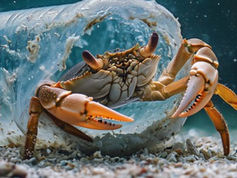Search
Corals and the Changing Oceans
- Lauren A. Moe

- Feb 26, 2023
- 3 min read
Updated: Jul 7, 2023
Corals are beautiful, living animals that form the base of reef ecosystems worldwide, and have evolved in our oceans over the past 200-300 million years. A single coral animal, called a polyp, consists of a mouth surrounded by tentacles and a simple stomach. Coral polyps reproduce by budding, which forms genetically identical copies of the original animal. Together, the polyps live in large colonies of hundreds to thousands and create what we think of when we hear the word “coral”. However, coral polyps can’t exist on their own; a symbiotic life is the key to their survival. Symbiosis occurs when a close relationship forms between two organisms of different species.
Each coral polyp has a tiny, single-celled plant roommate called zooxanthellae (pronounced “zoa-zan-thel-lay”). The plant lives in the tissues of a coral polyp and shares the nutrients needed for both to survive. Zooxanthellae are also responsible for the vibrant colors seen in different coral reefs around the world. Beyond the individual polyps, colonies of coral provide food and habitat to an estimated 25% of all marine life. They act as nursery grounds, protect coasts from storms, filter the run-off from land, and so much more.
Corals are slow growing animals who are incredibly picky about their surroundings. Ideal temperatures for coral are between 73-84ºF, and when water temperatures change too quickly, they become stressed. Think about it: if you were incredibly stressed, would you want to deal with a roommate on top of everything? When corals feel this change in water temperature, they expel their house plant roommates, exposing the white skeletons underneath. News articles are constantly surfacing showing reefs with little to no color, which is the result of this phenomena called coral bleaching. Without zooxanthellae to provide up to 90% of their nutrients, not only are they hungry, but they are also more susceptible to potentially fatal diseases. As of August 2022, 60% of the famous Great Barrier Reef off the coast of Australia had either moderate or severe levels of coral bleaching.

Left photo by Gary Bell / Oceanwideimages.com, right photo by Roger Grace / Greenpeace









Comments